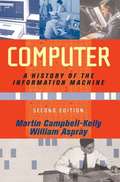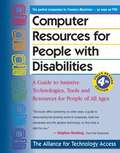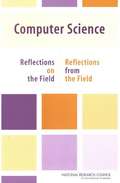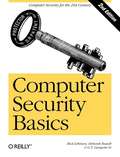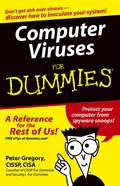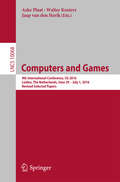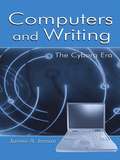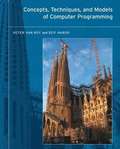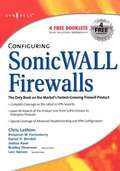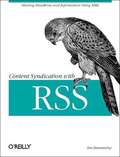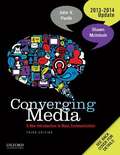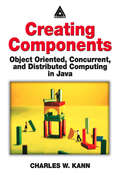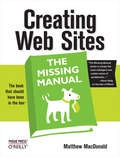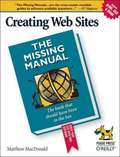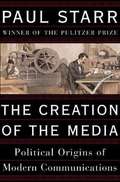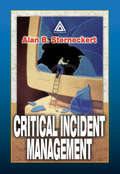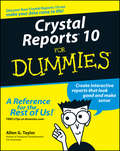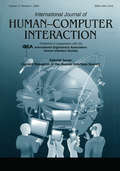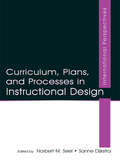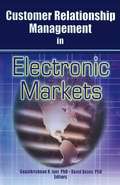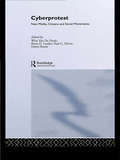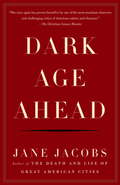- Table View
- List View
Computer
by Martin Campbell-Kelly William AsprayCampbell-Kelly (University of Warwick) and Aspray (Indiana University) describe the way computing was handled before the arrival of electronic computers, and recount the development of the mainframe computer. They review the origins of office machinery, early failed attempts to build a calculating engine, scientific war programs, the IBM system/360 family of computers, and the importance of real time for common commercial applications. The second edition expands the later sections on CD-ROMs, the internet, and web commerce. Annotation ©2004 Book News, Inc. , Portland, OR (booknews. com)
Computer
by William Aspray Martin Campbell-KellyComputer: A History of the Information Machine, Second Edition traces the story of the computer, and shows how business and government were the first to explore its unlimited, information-processing potential. Old-fashioned entrepreneurship combined with scientific know-how inspired now famous computer engineers to create the technology that became IBM. Wartime needs drove the giant ENIAC, the first fully electronic computer. Later, the PC enabled modes of computing that liberated people from room-sized, mainframe computers. This second edition now extends beyond the development of Microsoft Windows and the Internet, to include open source operating systems like Linux, and the rise again and fall and potential rise of the dot.com industries.
Computer Resources for People with Disabilities
by Alliance for Technology AccessA resource for people with disabilities who want to improve their lives through the use of technology.
Computer Science: Reflections on the Field, Reflections from the Field
by Committee on the Fundamentals of Computer Science:Challenges OpportunitiesComputer Science: Reflections on the Field, Reflections from the Fieldprovides a concise characterization of key ideas that lie at the core of computer science (CS) research. The book offers a description of CS research recognizing the richness and diversity of the field. It brings together two dozen essays on diverse aspects of CS research, their motivation and results. By describing in accessible form computer science’s intellectual character, and by conveying a sense of its vibrancy through a set of examples, the book aims to prepare readers for what the future might hold and help to inspire CS researchers in its creation.
Computer Security Basics, 2nd Edition
by Rick LehtinenThis is the must-have book for a must-know field. Today, general security knowledge is mandatory, and, if you who need to understand the fundamentals, Computer Security Basics 2nd Edition is the book to consult. The new edition builds on the well-established principles developed in the original edition and thoroughly updates that core knowledge. For anyone involved with computer security, including security administrators, system administrators, developers, and IT managers, Computer Security Basics 2nd Edition offers a clear overview of the security concepts you need to know, including access controls, malicious software, security policy, cryptography, biometrics, as well as government regulations and standards. This handbook describes complicated concepts such as trusted systems, encryption, and mandatory access control in simple terms. It tells you what you need to know to understand the basics of computer security, and it will help you persuade your employees to practice safe computing. Topics include: Computer security concepts Security breaches, such as viruses and other malicious programs Access controls Security policy Web attacks Communications and network security Encryption Physical security and biometrics Wireless network security Computer security and requirements of the Orange Book OSI Model and TEMPEST
Computer Security Basics, 2nd Edition
by G. T. Gangemi Rick LehtinenThis is the must-have book for a must-know field. Today, general security knowledge is mandatory, and, if you who need to understand the fundamentals, Computer Security Basics 2nd Edition is the book to consult. The new edition builds on the well-established principles developed in the original edition and thoroughly updates that core knowledge. For anyone involved with computer security, including security administrators, system administrators, developers, and IT managers, Computer Security Basics 2nd Edition offers a clear overview of the security concepts you need to know, including access controls, malicious software, security policy, cryptography, biometrics, as well as government regulations and standards. This handbook describes complicated concepts such as trusted systems, encryption, and mandatory access control in simple terms. It tells you what you need to know to understand the basics of computer security, and it will help you persuade your employees to practice safe computing. Computer security concepts Security breaches, such as viruses and other malicious programs Access controls Security policy Web attacks Communications and network security Encryption Physical security and biometrics Wireless network security Computer security and requirements of the Orange Book OSI Model and TEMPEST
Computer Viruses For Dummies
by Peter H. GregoryComputer viruses--just the thought of your trusty PC catching one is probably enough to make you sick. Thanks to the cyber-sickies who persist in coming up with new strains, there's a major new cyberattack nearly every day. Viruses sneak in, usually through e-mail.Fortunately, there are ways to inoculate and protect your computer. Computer Viruses For Dummies helps you:Understand the risks and analyze your PC's current conditionSelect, install, and configure antivirus softwareScan your computer and e-mailRid your computer of viruses it's already caughtUpdate antivirus software and install security patchesUse firewalls and spyware blockersProtect handheld PDAs from virusesAdopt safe computing practices, especially with e-mail and when you're surfing the NetWritten by Peter H. Gregory, coauthor of CISSP For Dummies and Security + For Dummies, Computer Viruses For Dummies goes beyond viruses to explain other nasty computer infections like Trojan horses, HiJackers, worms, phishing scams, spyware, and hoaxes. It also profiles major antivirus software to help you choose the best program(s) for your needs.Remember, if you don't protect your computer, not only do you risk having your computer infiltrated and your data contaminated, you risk unknowingly transmitting a virus, worm, or other foul computer germ to everybody in your address book! This guide will help you properly immunize your PC with antivirus software now and install updates and security patches that are like booster shots to keep your software protected against new viruses.
Computers and Games: 9th International Conference, CG 2016, Leiden, The Netherlands, June 29 – July 1, 2016, Revised Selected Papers (Lecture Notes in Computer Science #10068)
by Aske Plaat Walter Kosters Jaap Herik1 feel privileged that the J(jh Advances in Computer Games Conference (ACG 10) takes place in Graz, Styria, Austria. It is the frrst time that Austria acts as host country for this major event. The series of conferences started in Edinburgh, Scotland in 1975 and was then held four times in England, three times in The Netherlands, and once in Germany. The ACG-10 conference in Graz is special in that it is organised together with the 11th World Computer#65533; Chess Championship (WCCC), the Sth Computer Olympiad (CO), and the European Union Y outh Chess Championship. The 11 th WCCC and ACG 10 take place in the Dom im Berg (Dome in the Mountain), a high-tech space with multimedia equipment, located in the Schlossberg, in the centre of the city. The help of many sponsors (large and small) is gratefully acknowledged. They will make the organisation of this conference a success. In particular, 1 would like to thank the European Union for designating Graz as the Cultural Capital of Europe 2003. There are 24 accepted contributions by participants from all over the world: Europe, Japan, USA, and Canada. The specific research results ofthe ACG 10 are expected to tind their way to general applications. The results are described in the pages that follow. The international stature together with the technical importance of this conference reaffrrms the mandate of the International Computer Games Association (ICGA) to represent the computer-games community.
Computers and Writing: The Cyborg Era
by James A. InmanIn this book, James A. Inman explores the landscape of the contemporary computers and writing community. Its six chapters engage critical issues, including redefining the community's generally accepted history, connecting its contemporary innovators with its long-standing spirit of innovation, advocating for increased access and diversity, and more. Between chapters, readers will find "Community Voices" sections, which provide a snapshot of the contemporary computers and writing community and introduce, in a non-hierarchical form, more than 100 of its members from around the world, in their own voices. Computers and Writing: The Cyborg Era features a simultaneous emphasis on individuals, communities, and contexts they share; a creative rethinking of the character and values of the computers and writing community; a holistic exploration of meaning-making; and an activist approach to pedagogy. It is a must-read book for anyone interested in rhetoric, technology, and pedagogy, including faculty, graduate students, and colleagues in professions outside the academy.
Concepts, Techniques, and Models of Computer Programming
by Peter Van-Roy Seif HaridiThis innovative text presents computer programming as a unified discipline in a way that is both practical and scientifically sound. The book focuses on techniques of lasting value and explains them precisely in terms of a simple abstract machine. The book presents all major programming paradigms in a uniform framework that shows their deep relationships and how and where to use them together. After an introduction to programming concepts, the book presents both well-known and lesser-known computation models ("programming paradigms"). Each model has its own set of techniques and each is included on the basis of its usefulness in practice. The general models include declarative programming, declarative concurrency, message-passing concurrency, explicit state, object-oriented programming, shared-state concurrency, and relational programming. Specialized models include graphical user interface programming, distributed programming, and constraint programming. Each model is based on its kernel language--a simple core language that consists of a small number of programmer- significant elements. The kernel languages are introduced progressively, adding concepts one by one, thus showing the deep relationships between different models. The kernel languages are defined precisely in terms of a simple abstract machine. Because a wide variety of languages and programming paradigms can be modeled by a small set of closely related kernel languages, this approach allows programmer and student to grasp the underlying unity of programming. The book has many program fragments and exercises, all of which can be run on the Mozart Programming System, an Open Source software package that features an interactive incremental development environment.
Configuring SonicWALL Firewalls
by Simon Desmeules Barry J. StiefelConfiguring SonicWALL Firewal is the first book to deliver an indepth look at the SonicWALL firewall product line. It covers all of the aspects of the SonicWALL product line from the SOHO devices to the Enterprise SonicWALL firewalls. Also covered are advanced troubleshooting techniques and the SonicWALL Security Manager. This book offers novice users a complete opportunity to learn the SonicWALL firewall appliance. Advanced users will find it a rich technical resource.
Content Syndication with RSS
by Ben HammersleyRSS is sprouting all over the Web, connecting weblogs and providing news feeds. Originally developed by Netscape in 1999, RSS (which can stand for RDF Site Summary, Rich Site Summary, or Really Simple Syndication) is an XML-based format that allows web developers to describe and syndicate web site content. Using RSS files allows developers to create a data feed that supplies headlines, links, and article summaries from a web site. Other sites can then incorporate them into their pages automatically. Although RSS is in widespread use, people struggle with its confusing and sometimes conflicting documentation and versions. Content Syndication with RSS is the first book to provide a comprehensive reference to the specifications and the tools that make syndication possible. Content Syndication with RSS offers webloggers, developers, and the programmers who support them a thorough explanation of syndication in general and RSS in particular. Written for web developers who want to offer XML-based feeds of their content, as well as developers who want to use the content that other people are syndicating, the book explores and explains metadata interpretation, different forms of content syndication, and the increasing use of web services in this field. This concise volume begins with an introduction to content syndication on the Internet: its purpose, limitations, and traditions, and answers the question of why would you consider "giving your content away" like this? Next, the book delves into the architecture of content syndication with an overview of the entire system, from content author to end user on another site. You'll follow the flow of data: content, referral data, publish-and-subscribe calls, with a detailed look at the protocols and standards possible at each step. Topics covered in the book include: Creating XML syndication feeds with RSS 0.9x and 2.0 Beyond headlines: creating richer feeds with RSS 1.0 and RDF metadata Using feeds to enrich a site or find information Publish and subscribe: intelligent updating News aggregators, such as Meerkat, Syndic8, and Newsisfree, and their web services Alternative industry-centric standards If you're interested in producing your own RSS feed, this step-by-step guide to implementation is the book you'll want in hand.
Converging Media: A New Introduction to Mass Communication
by John V. Pavlik Shawn McintoshDigital media is changing the ways in which we communicate: we watch TV and movies online, call friends on computers, and read newspapers on cell phones. Placing convergence at the center of the discussion, Converging Media: A New Introduction to Mass Communication uses the technologies we employ everyday to explain our current media environment - and to project where we might be headed. Rather than discussing each media industry in isolation, Converging Media shows how each branch of media (print, visual, and audio) relates to and influences the others. This enables students to see the inextricable and dynamic relationship between converging media and traditional media formats.
Creating Components: Object Oriented, Concurrent, and Distributed Computing in Java
by Charles W. KannConcurrency is a powerful technique for developing efficient and lightning- fast software. For instance, concurrency can be used in common applications such as online order processing to speed processing and ensure transaction reliability. However, mastering concurrency is one of the greatest challenges for both new and veteran programmers. Softwar
Creating Web Sites: The Missing Manual (Missing Manual)
by Matthew MacdonaldThink you have to be a technical wizard to build a great web site? Think again. For anyone who wants to create an engaging web site--for either personal or business purposes-- Creating Web Sites: The Missing Manual demystifies the process and provides tools, techniques, and expert guidance for developing a professional and reliable web presence. Like every Missing Manual, you can count on Creating Web Sites: The Missing Manual to be entertaining and insightful and complete with all the vital information, clear-headed advice, and detailed instructions you need to master the task at hand. Author Matthew MacDonald teaches you the fundamentals of creating, maintaining, and updating an effective, attractive, and visitor-friendly web site--from scratch or from an existing site that's a little too simple or flat for your liking. Creating Web Sites: The Missing Manual doesn't only cover how to create a well-designed, appealing, smart web site that is thoroughly up to date and brimming with the latest features. It also covers why it's worth the effort by explaining the rationale for creating a site in the first place and discussing what makes a given web site particularly aesthetic, dynamic, and powerful. It further helps you determine your needs and goals and make well informed design and content decisions. Creating Web Sites: The Missing Manual includes a basic primer on HTML, working with JavaScript, and incorporating services like Paypal's shopping cart, Amazon's associate program, and Google AdSense and AdWords. It delivers advanced tricks for formatting, graphics, audio and video, as well as Flash animation and dynamic content. And you'll learn how to identify and connect with your site's audience through forms, forums, meta tags, and search engines. This isn't just another dry, uninspired book on how to create a web site. Creating Web Sites: The Missing Manual is a witty and intelligent guide for all of you who are ready to make your ideas and vision a web reality.
Creating Web Sites: The Missing Manual
by Matthew MacdonaldThink you have to be a technical wizard to build a great web site? Think again. For anyone who wants to create an engaging web site--for either personal or business purposes-- Creating Web Sites: The Missing Manual demystifies the process and provides tools, techniques, and expert guidance for developing a professional and reliable web presence. Like every Missing Manual, you can count on Creating Web Sites: The Missing Manual to be entertaining and insightful and complete with all the vital information, clear-headed advice, and detailed instructions you need to master the task at hand. Author Matthew MacDonald teaches you the fundamentals of creating, maintaining, and updating an effective, attractive, and visitor-friendly web site--from scratch or from an existing site that's a little too simple or flat for your liking. Creating Web Sites: The Missing Manual doesn't only cover how to create a well-designed, appealing, smart web site that is thoroughly up to date and brimming with the latest features. It also covers why it's worth the effort by explaining the rationale for creating a site in the first place and discussing what makes a given web site particularly aesthetic, dynamic, and powerful. It further helps you determine your needs and goals and make well informed design and content decisions. Creating Web Sites: The Missing Manual includes a basic primer on HTML, working with JavaScript, and incorporating services like Paypal's shopping cart, Amazon's associate program, and Google AdSense and AdWords. It delivers advanced tricks for formatting, graphics, audio and video, as well as Flash animation and dynamic content. And you'll learn how to identify and connect with your site's audience through forms, forums, meta tags, and search engines. This isn't just another dry, uninspired book on how to create a web site. Creating Web Sites: The Missing Manual is a witty and intelligent guide for all of you who are ready to make your ideas and vision a web reality.
The Creation of the Media: Political Origins of Modern Communications
by Paul StarrAmerica's leading role in today's information revolution may seem simply to reflect its position as the world's dominant economy and most powerful state. But by the early nineteenth century, when the United States was neither a world power nor a primary center of scientific discovery, it was already a leader in communications-in postal service and newspaper publishing, then in development of the telegraph and telephone networks, later in the whole repertoire of mass communications.<P><P> In this wide-ranging social history of American media, from the first printing press to the early days of radio, Paul Starr shows that the creation of modern communications was as much the result of political choices as of technological invention. His original historical analysis reveals how the decisions that led to a state-run post office and private monopolies on the telegraph and telephone systems affected a developing society. He illuminates contemporary controversies over freedom of information by exploring such crucial formative issues as freedom of the press, intellectual property, privacy, public access to information, and the shaping of specific technologies and institutions. America's critical choices in these areas, Starr argues, affect the long-run path of development in a society and have had wide social, economic, and even military ramifications. The Creation of the Media not only tells the history of the media in a new way; it puts America and its global influence into a new perspective.
Critical Incident Management
by Alan B. SterneckertMost businesses are aware of the danger posed by malicious network intruders and other internal and external security threats. Unfortunately, in many cases the actions they have taken to secure people, information and infrastructure from outside attacks are inefficient or incomplete. Responding to security threats and incidents requires a competent
Critical Reflections on Career Education and Guidance: Promoting Social Justice within a Global Economy
by Barrie A. Irving Beatriz MalikFirst Published in 2004. Routledge is an imprint of Taylor & Francis, an informa company.
Crystal Reports 10 For Dummies
by Allen G. TaylorWouldyoureadinformationpresentedlikethis?No. It's just not natural. Sometimes presentation is almost as important as content. When you create a report, the goal is to provide information for readers in a format they can readily understand.Crystal Reports 10 For Dummies, the latest version of the most popular report writer in the world, shows you how to create simple or sophisticated reports, turning data into interactive, actionable reports that convey what's happening in your business. You can progress cover-to-cover or use the index to find out how to:Give your reports more pizzazz by using the correct fonts, color, drop shadows, graphic elements, and moreIntegrate elements from multiple, non-database sourcesGroup sort, total result sets, cross-tab reports, and add formulas, charts, or mapsPrint reportsUse customized Business Views gleaned from the same information to provide each reader with information he or she needs to know without spilling all the beans, sales figures, marketing information, or whateverPresent multi-dimensional data in OLAP (Online Analytical Processing) cubesGet ideas from sample reports on the companion Web siteWritten by Allen G. Taylor, nationally known lecturer, teacher, and author of over 20 books, including Database Development for Dummies, Crystal Reports 10 For Dummies makes it crystal clear how to:Store your information securely in Crystal RepositoryUse Crystal Analysis 10 to display OLAP data so you and your report's readers can analyze the information in an online environmentUse Crystal Enterprise to put Crystal Reports online for viewing by hundreds or thousands of people in your organizationWhether you want to dazzle your company's CEO and shareholders, motivate the sales force, or simply share database information cogently, with Crystal Reports 10 For Dummies you not only make your point, you an impression. When your reports look professional, you look professional.
Current Research of the Human Interface Society: A Special Issue of the international Journal of Human-computer Interaction
by Osamu KataiThis special issue is the first opportunity to introduce the research activities of the Human Interface Society. The first article gives a microworld approach to identify design requirements for better situation awareness. Next, a focus on evaluation of organizational structure in emergency situations from the communication viewpoints is examined,
Curriculum, Plans, and Processes in Instructional Design: International Perspectives
by Norbert M. Seel Sanne DijkstraCurriculum, Plans, and Processes in Instructional Design: International Perspectives presents perspectives on the relationship between curriculum research and instructional design, as well as new developments in the use of information and communication technology. In their introductory chapter, the editors provide an overview of the volume and introduce the discussions found in three sections: *The chapters in Part I (Theoretical Foundations and Innovations) describe and discuss new theoretical and innovative approaches to instructional design that integrate curriculum development with information and communication technologies. *Part II (Curriculum Development, Instructional Design, and Information Technology) focuses on curriculum development and its impact on models of instructional design. *Part III (Information and Communication Technology and Instructional Design) addresses the challenge of advancing information and communication technologies for instructional planning and curriculum development. Prominent researchers and practitioners from instructional design, as well as the learning sciences--from both the U.S. and around the world--have contributed to this volume. This volume is a valuable resource for graduate students, scholars, and researchers in the fields of instructional design and educational technology, as well as for those who wish to develop expertise in training in industrial, military, public and academic organizations.
Customer Relationship Management in Electronic Markets
by Gopalkrishnan R Iyer David BejouDiscover an important tool in the development of new marketing strategies for satisfying online customers! Edited by two experts in the fields of business and marketing, Customer Relationship Management in Electronic Markets is designed to help you build Internet relationships that lead to customer retention and long-term loyalty. With this book, you will be able to offer customers the benefits they seek in the virtual marketplace and serve their best interests. Examining Web sites, e-mail, data mining, and other technology, this valuable tool can help you attract and keep the customers who will be the most profitable for your business. Despite many predictions that electronic marketing would create high profits for lower costs, many businesses have been discouraged by low yields due to ineffectual methods of obtaining and maintaining customers. Customer Relationship Management in Electronic Markets provides multiple frameworks, strategies, and techniques around which to organize your company&’s electronic marketing plans. It shows you how to calculate trends, predict customer loss and gain, and prevent dissolution through analysis of the customer&’s ever-changing needs. This volume also utilizes examples of real successful companies that have used the Internet to the fullest extent, like Staples, Dell, and Amazon.com. Customer Relationship Management in Electronic Markets is an excellent resource for individuals engaged in any aspect of business relationships, from customer service managers, consultants and corporate trainers in marketing, to owners of major corporations, online businesses and entrepreneurs, and students in the field. Specifically, you will gain information on the following: business-to-business (B2B) and business-to-customer (B2C) exchanges-similarities, differences, and how the Internet has changed these relationships the prospects of the Internet for marketing and customer relationships-predictions, positive effects, and negative effects from its inception to today how to develop and maintain a loyal customer base via the Internet improving B2B exchanges and business buyer relationship management through seamless Internet integration how to create a Web site that satisfies loyal customers and draws in new customers Featuring several charts, tables, and graphs, this guide provides effective measures that you can institute to ensure your company&’s longevity. Customer Relationship Management in Electronic Markets will help you create marketing strategies that will successfully meet the needs of your customers and enhance your business reputation.
Cyberprotest: New Media, Citizens and Social Movements
by Wim Van De Donk Brian D. Loader Paul G. Nixon Dieter RuchtEver since the anti-globalisation protests in Seattle in 1999 the adoption of new information and communications technologies (ICTs) by social movement activists has offered the prospect for the development of global cyberprotest. The Internet with its transnational many-to-many communication facility offers a revolutionary potential for social movements to go online and circumvent the 'official' messages of political and commercial organisations and the traditional media, by speaking directly to the citizens of the world. Furthermore the use of electronic mail (e-mail), mailing lists, websites, electronic forums and other online applications provide powerful media tools for co-ordinating the activity of often physically dispersed movement actors. Moreover, ICTs may also contribute to the important function of social movements of shaping collective identity and countering the claims and arguments of established political interests. A growing body of literature during the last decades of the twentieth century attests to the significant impact SMs have had upon the restructuring of the political landscape. Most of that literature addresses the more traditional actors and institutions (e.g. parliaments, political parties, bureaucracy etc.). Less attention has been devoted to those manifestations of political action that are concentrated around social movements and all kinds of more or less institutionalised and sustainable forms of citizen mobilisation. This book is a collection of cases that take a critical look into the way ICTs are finding their way into the world of social movements
Dark Age Ahead
by Jane JacobsIn this indispensable book, urban visionary Jane Jacobs--renowned author of The Death and Life of Great American Cities and The Economy of Cities--convincingly argues that as agrarianism gives way to a technology-based future, we stand on the brink of a new dark age, a period of cultural collapse. Jacobs pinpoints five pillars of our culture that are in serious decay: community and family; higher education; the effective practice of science; taxation, and government; and the self-regulation of the learned professions. The corrosion of these pillars, Jacobs argues, is linked to societal ills such as environmental crisis, racism, and the growing gulf between rich and poor. But this is a hopeful book as well as a warning. Drawing on her vast frame of reference-from fifteenth-century Chinese shipbuilding to Ireland's cultural rebirth-Jacobs suggests how the cycles of decay can be arrested and our way of life renewed. Invigorating and accessible, Dark Age Ahead is not only the crowning achievement of Jane Jacobs' career, but one of the most important works of our time.From the Trade Paperback edition.
